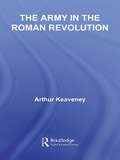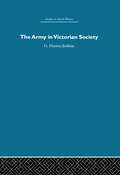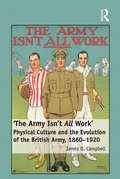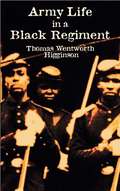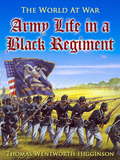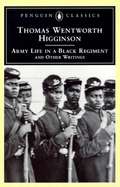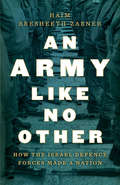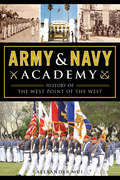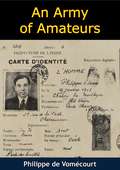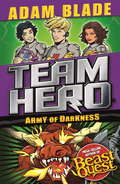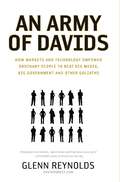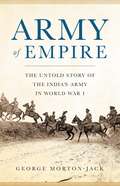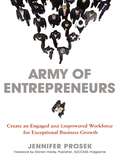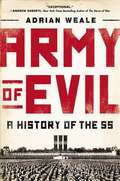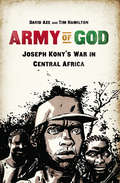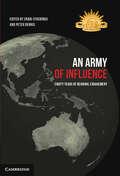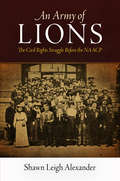- Table View
- List View
The Army in the Roman Revolution
by Arthur KeaveneyThe Roman Revolution is one of the most momentous periods of change in history, in which an imperial but quasidemocratic power changed into an autocracy. This book studies the way the Roman army changed in the last eighty years of the Republic, so that an army of imperial conquest became transformed into a set of rival personal armies under the control of the triumvirs. It emphasizes the development of what has often been regarded as a static monolithic institution, and its centrality to political change.
The Army in Victorian Society
by G. Harries-JenkinsAlthough in Victorian society the Army was the aristocratic backbone of England, it was persistently engaged in fighting Colonial Wars.
'The Army Isn't All Work': Physical Culture and the Evolution of the British Army, 1860–1920
by James D. CampbellBetween the Crimean War and the end of the First World War the British Army underwent a dramatic change from being an anachronistic and frequently ineffective organization to being perhaps the most professional and highly trained army in the world. Historians have tended to view that transformation through the successive political reform efforts of those years, but have largely overlooked the ways in which the Army transformed itself from within. This change was effected through the modernization of training, operational and leadership doctrines. The adoption of formal physical training and organized games played a central part in this process. With its origins in elite public schools and upper-class country homes, the Army's philosophy of Athleticism was a part of the ethos of 'muscular Christianity' widely held in contemporary British institutions. Under the potent influence of this philosophy, military sport went from a means of keeping soldiers from drink and the officers from duty, to an institutionalized form of combat training. This book documents the origins and development of formal physical training in the late Victorian Army and the ways in which the Army's gymnastic training evolved into a vital building block of the process of turning a civilian into a fighting man. It also assesses the nature and extent of British military sport, particularly regimental sports, during this period of evolution for the Army. Through an investigation of the Army's physical culture during this dynamic period, one can gain an understanding of not only how the Army's change from within occurred, but also of some of the important links between the Army and its parent society.
Army JROTC Leadership Education and Training (LET #3)
by Pearson Custom PublishingArmy JROTC Leadership Education and Training (LET 3) Third Year of A Character and Leadership Development Program
Army JROTC Leadership Education and Training, First Year
by Pearson Custom PublishingThis book introduces you to the U.S. Army Junior Reserve Officers' Training Corps (JROTC) Program, its mission, and the Leadership Education and Training (LET) curriculum for this first level of your instruction. Completing the material in this course requires discipline and hard work, but the reward is well worth your effort. Through Army JROTC, you are building a foundation that will last a lifetime.
Army Life in a Black Regiment
by Thomas Wentworth HigginsonThomas Wentworth Higginson, a Unitarian minister, was a fervent member of New England's abolitionist movement, an active participant in the Underground Railroad, and not only corresponded with John Brown before the ill-fated raid on Harper's Ferry, but was part of a group that supplied material aid to Brown. When the Civil War broke out, his reputation, enhanced by his impassioned articles about Denmark Vesey and Nat Turner in the Atlantic, made him the perfect candidate to head the first regiment of emancipated slaves, and in 1862, he was commissioned as a colonel for the troops training in the Sea Islands off the coast of the Carolinas. Army Life in a Black Regiment is Higginson's stirring account of his wartime experiences. Shaped by American Romanticism and imbued with Higginson's interest in both man and nature, the narrative ranges from detailed reports on daily life to a vivid description of the author's near escape from cannon fire to sketches that conjure up the beauty and mystery of the Sea Islands.
Army Life in a Black Regiment (Civil War)
by Thomas Wentworth Higginson"Army Life in a Black Regiment has some claim to be the best written narrative to come from the Union [side] during the Civil War. Higginson's picture of the battle which was the origin of "praise the Lord and pass the ammunition" and his reading of the Emancipation Proclamation to the black regiment are unsurpassed for eloquence." — historian Henry Steele CommagerOriginally a series of essays, this important volume was written by a Union colonel from New England, in charge of African-American troops training on the Sea Islands off the coast of the Carolinas. A lively and detailed wartime diary, the book offers a refreshing portrait of life in the Union Army from an officer's point of view, recording opinions of other commanders and capturing the raw humor that develops among the men in combat. Higginson's descriptions of the soldiers, routines of camp life, and southern landscapes are unforgettable, as is the account of his near escape from a cannon ball. An unusual historical document intended to introduce new generations of readers to an American past that should not be forgotten, Army Life in a Black Regiment will be invaluable to students of Black History and the American Civil War.
Army Life in a Black Regiment (The World At War)
by Thomas Wentworth HigginsonThomas Wentworth Higginson (December 22, 1823 – May 9, 1911) was an American Unitarian minister, author, abolitionist, and soldier. He was active in the American Abolitionism movement during the 1840s and 1850s, identifying himself with disunion and militant abolitionism. He was a member of the Secret Six who supported John Brown. During the Civil War, he served as colonel of the 1st South Carolina Volunteers, the first federally authorised black regiment, from 1862–1864. Following the war, Higginson devoted much of the rest of his life to fighting for the rights of freed slaves, women and other disfranchised peoples. (Excerpt from Wikipedia)
Army Life in a Black Regiment and Other Writings
by Thomas Wentworth HigginsonA stirring account of wartime experiences from the leader of the first regiment of emancipated slavesThomas Wentworth Higginson, a Unitarian minister, was a fervent member of New England's abolitionist movement, an active participant in the Underground Railroad, and part of a group that supplied material aid to John Brown before his ill-fated raid on Harpers Ferry. When the Civil War broke out, Higginson was commissioned as a colonel of the black troops training in the Sea Islands off the coast of the Carolinas. Shaped by American Romanticism and imbued with Higginson's interest in both man and nature, Army Life in a Black Regiment ranges from detailed reports on daily life to a vivid description of the author's near escape from cannon fire, to sketches that conjure up the beauty and mystery of the Sea Islands. This edition of Army Life features as well a selection of Higginson's essays, including 'Nat Turner's Insurrection' and 'Emily Dickinson's Letters. ''Has some claim to be the best written narrative to come from the Union during the Civil War. '- Henry Steele CommagerIntroduction and Notes by R. D. MADISON
An Army Like No Other: How the Israel Defense Forces Made a Nation
by Haim Bresheeth-ZabnerA history of the IDF that argues that Israel is a nation formed by its army.The Israeli army, officially named the Israel Defence Forces (IDF), was established in 1948 by David Ben-Gurion, Israel's first prime minister, who believed that 'the whole nation is the army'. In his mind, the IDF was to be an army like no other. It was the instrument that might transform a diverse population into a new people. Since the foundation of Israel, therefore, the IDF has been the largest, richest and most influential institution in Israel's Jewish society and is the nursery of its social, economic and political ruling class. In this fascinating history, Bresheeth charts the evolution of the IDF from the Nakba to the continued assaults upon Gaza, and shows that the state of Israel has been formed out of its wars. He also gives an account of his own experiences as a young conscript during the 1967 war. He argues that the army is embedded in all aspects of daily life and identity. And that we should not merely see it as a fighting force enjoying an international reputation, but as the central ideological, political and financial institution of Israeli society. As a consequence, we have to reconsider our assumptions on what any kind of peace might look like.
Army Medical Research and Development Infrastructure Planning: Proceedings Of A Workshop
by National Academies of Sciences, Engineering, and Medicine Division on Engineering and Physical Sciences Board on Army Research and DevelopmentAt the request of the U.S. Army, the Board on Army Research and Development of the National Academies of Sciences, Engineering, and Medicine conducted a 3-day workshop to explore how the Army can improve its strategic medical infrastructure planning with a view to 2035. The workshop, held July 14-16, 2020, brought together experts and key stakeholders from academia, industry, and government. The Army requires fidelity, consistency, and predictability in planning and managing research, development, test, and evaluation resources for medical infrastructure across all appropriation sources to effectively develop, deliver, and respond to military medical capability needs. In response to the Army’s requirement, the workshop was designed to address the components of a sustainable, reinforcing enterprise framework (organizational and fiscal). Presentations and discussions examined roles, responsibilities, and coordinating mechanisms among major stakeholders of battlefield medicine; case studies of comparably complex non-government enterprise solutions; and opportunities to link ends, ways, and means for improvements. This publication summarizes the presentations and discussion of the workshop.
Army & Navy Academy: History of the West Point of the West
by Alexander MuiOnce a staple of American society, military schools are a dying breed, with fewer than thirty remaining. Historically, most military academies existed in the South and along the East Coast. However, Colonel Thomas A. Davis pushed this tradition westward when he founded the San Diego Army and Navy Academy in 1910. Davis pioneered a novel education and leadership training structure for young men that predated the Boy Scouts and JROTC Program. From this single institution sprang the Brown Military Academy, Davis Military Academy, San Diego Military Academy and more. Author Alexander Mui chronicles the endurance of this revered academy through countless trials, wars, economic depressions and the nationwide military school decline until it remained the last traditional military academy west of the Rocky Mountains.
Army Nurse Corps Voices from the Vietnam War: Eight Women, One War (Palgrave Studies in Oral History)
by Janet D. TannerThis book provides an oral history of women who served in the U.S. Army Nurse Corps during the Vietnam War. It follows the trajectory of eight women’s lives from their decision to become nurses, to surgical and evacuation hospitals in Vietnam, and then home to face the consequences of war on their personal and professional lives. It documents their lived experience in Vietnam and explores the memories and personal stories of nurses who treated injured American soldiers, Vietnamese civilians, and the enemy. Their voices reveal the physical and emotional challenges, trauma, contradictions, and lingering effects of war on their lives. Women in the U.S. Army in Vietnam feared the enemy but also sexual violence and harassment: the experiences this book documents also shed light on the extent of historical sexual abuse in the military.
The Army of Alexander the Great
by Stephen EnglishAlexander the Great is one of the most famous men in history, and many believe he was the greatest military genius of all time (Julius Caesar wept at the feet of his statue in envy of his achievements). Most of his thirteen year reign as king of Macedon was spent in hard campaigning which conquered half the known world, during which he was never defeated in open battle and never besieged a city he did not take. Yet, while biographies of Alexander abound, there are relatively few full-length books dedicated to the Macedonian army which made his dazzling conquests possible and which proved itself the most formidable machine of the age.Stephen English investigates every aspect of the Macedonian forces, analysing the recruitment, equipment, organisation, tactics, command and control of the fighting arms (including the famous pike phalanxes, elite Hypaspists and incomparable Companion cavalry),Some of Alexander's most famous battles and sieges are described in detail to show the army in action. With forensic thoroughness he draws on recent archaeological evidence and scholarship to present a detailed portrait of the army which demonstrated a superiority over its opponents equal to (but much longer-lasting than) that enjoyed by the German forces in the blitzkrieg campaigns of 1939/40. Alexnader's navy is also covered.
An Army of Amateurs
by Philippe De VomécourtThis book is the fascinating firsthand account of SOE agent Philippe Vomécourt's wartime experiences and records the heroic efforts in the French resistance in Nazi-dominated France."Many books dealing with the work of the French Resistance have been published on this side of the Channel. Most of them have been the personal stories of gallant men and women, illuminating that corner of the picture that they saw. Here in Monsieur de Vomécourt's book is a wider frame of reference which enables us to see how the spirit and forces of Resistance grew in France first into a gadfly nuisance and ultimately into a serious threat to German security. It shows, too, what it meant to be a member of the Resistance, and what it cost in blood and tears.Monsieur de Vomécourt is in a good position to tell this story. He was in at the beginning in June 1940 with his brothers. Indeed, they can fairly claim to have been the first organizers and leaders, and Monsieur de Vomécourt tells a truly remarkable story.
Army of Charles II
by John ChildsFirst published in 2006. Routledge is an imprint of Taylor & Francis, an informa company.
Army of Darkness: Series 3, Book 3 (Team Hero Ser. #11)
by Adam BladeX-Men meets Beast Quest at the school for superheroes! An epic new adventure series from bestselling author Adam Blade - with amazing comic-book style illustrations. Team Hero Vs the world!Jack, Danny and Ruby must stop a powerful foe from regaining an ancient sceptre and unleashing its dark magic. But on their quest, they discover some new, unexpected enemies ...There are FOUR thrilling adventures to collect in this series - don't miss out!
Army of Darkness: Series 3 Book 3 (Team Hero #11)
by Adam BladeX-Men meets Beast Quest at the school for superheroes! An epic new adventure series from bestselling author Adam Blade - with amazing comic-book style illustrations. Team Hero Vs the world!Jack, Danny and Ruby must stop a powerful foe from regaining an ancient sceptre and unleashing its dark magic. But on their quest, they discover some new, unexpected enemies ...There are FOUR thrilling adventures to collect in this series - don't miss out!
An Army of Davids: How Markets and Technology Empower Ordinary People to Beat Big Media, Big Government, and Other Goliaths
by Glenn ReynoldsThere was a time in the not-too-distant past when large companies and powerful governments reigned supreme over the little guy. But new technologies are empowering individuals like never before, and the Davids of the world-the amateur journalists, musicians, and small businessmen and women-are suddenly making a huge economic and social impact. In Army of Davids, author Glenn Reynolds, the man behind the immensely popular Instapundit.com, provides an in-depth, big-picture point-of-view for a world where the small guys matter more and more. Reynolds explores the birth and growth of the individual's surprisingly strong influence in: arts and entertainment, anti-terrorism, nanotech and space research, and much more. The balance of power between the individual and the organization is finally evening out. And it's high time the Goliaths of the world pay attention, because, as this book proves, an army of Davids is on the rise. Endorsements: "George Orwell feared that technology would enable dictators to enslave the masses. Glenn Reynolds shows that technology can empower individuals to determine their own futures and to defeat those who would enslave us. This is a book of profound importance-and also a darn good read." -MICHAEL BARONE, senior writer at U.S. News & World Report and author of Hard America, Soft America "Blogger extraordinaire Glenn Reynolds shows how average Americans can use new technologies to overcome the twin demons of corporate greed and incompetent government. Reynolds is a compelling evangelist for the power of the individual to change our world." -ARIANNA HUFFINGTON, author of Pigs at the Trough and Fanatics and Fools "A smart, fun tour of a major social and economic trend. From home-brewed beer to blogging, Glenn Reynolds is an engaging, uniquely qualified guide to the do-it-yourself movements transforming business, politics, and media." -VIRGINIA POSTREL, Forbes columnist and author of The Future and its Enemies and The Substance of Style "A student in her dorm room now commands the resources of a multi-million dollar music recording or movie editing studio of not so many years ago. The tools of creativity have been democratized and the tools of production are not far behind (Karl Marx take note). Glenn Reynolds's beguiling new book tells the insightful story of how an 'army of Davids' is inheriting the Earth, leaving a trail of obsolete business models not to mention cultural, economic, and political institutions in its wake." -RAY KURZWEIL, scientist, inventor, and author of several books including The Singularity is Near 'Must-read,' 'gotta have,' 'culture-changing' . . . I am suspicious of blurbs with such overused plugs. But Glenn Reynolds's An Army of Davids is in fact a must-read new book that you gotta have if you are going to understand the culture-changing forces that are unleashed and at work across the globe. -HUGH HEWITT, syndicated talk radio host and author of Blog and Painting the Map Red "Glenn Reynolds has written an essential book for understanding how technology and markets are creating a bottom-up shift in power to ordinary people that is changing business, government, and our world. Packed with fresh ideas and adorned with graceful prose, An Army of Davids is a masterpiece." -JOE TRIPPI, author of The Revolution Will Not Be Televised
Army of Empire: The Untold Story of the Indian Army in World War I
by George Morton-JackDrawing on untapped new sources, the first global history of the Indian Expeditionary Forces in World War IWhile their story is almost always overlooked, the 1.5 million Indian soldiers who served the British Empire in World War I played a crucial role in the eventual Allied victory. Despite their sacrifices, Indian troops received mixed reactions from their allies and their enemies alike-some were treated as liberating heroes, some as mercenaries and conquerors themselves, and all as racial inferiors and a threat to white supremacy. Yet even as they fought as imperial troops under the British flag, their broadened horizons fired in them new hopes of racial equality and freedom on the path to Indian independence. Drawing on freshly uncovered interviews with members of the Indian Army in Iraq and elsewhere, historian George Morton-Jack paints a deeply human story of courage, colonization, and racism, and finally gives these men their rightful place in history.
Army of Entrepreneurs: Creating an Engaged and Empowered Workforce for Exceptional Business Growth
by Jennifer ProsekProsek (founder and CEO of a public relations firm) shares her secrets to creating a successful business. Her main point is that each employee must feel like the owner of the business, thus creating motivation and a positive attitude. Part one of the text introduces and discusses Prosek's business model. Part two tackles the mechanics of implementing her strategies into one's own business, such as training for all employees, and the use of technology. Part three offers a conclusion and a chapter devoted to addressing naysayers. An appendix listing additional resources is included. Annotation ©2011 Book News, Inc. , Portland, OR (booknews. com)
Army of Evil: A History of the SS
by Adrian WealeIn Nazi Germany, they were called the Schutzstaffel. The world would know them as the dreaded SS—the most loyal and ruthless enforcers of the Third Reich… It began as a small squad of political thugs. Yet by the end of 1935, the SS had taken control of all police and internal security duties in Germany—ranging from local village “gendarmes” all they way up to the secret political police and the Gestapo. And by 1944 the militarized Waffen SS had more than eight hundred thousand men serving in the field, even rivaling Germany’s regular armed forces, the Wehrmacht. In Army of Evil: A History of the SS, author Adrian Weale delves into materials not previously available, including recently released intelligence files, the most up-to-date research and rare and never-before-published photographs. Going beyond the myths and characterizations, this comprehensive account reveals the reality of the SS as a cadre of unwavering political fanatics and power-seeking opportunists who slavishly followed an ideology that disdained traditional morality, and were prepared to implement it to the utmost, murderous extreme that ultimately resulted in the Holocaust. This is a definitive historical narrative of the birth, legacy, and ultimate demise of one of the most feared political and military organizations ever known, and those twisted, cruel men who were responsible for one of the most appalling crimes against humanity in all history. .
Army of God: Joseph Kony's War in Central Africa
by David Axe Tim HamiltonJoseph Kony is the most dangerous guerilla leader in modern African history. It started with a visit from spirits. In 1991, Kony claimed that spiritual beings had come to him with instructions: he was to lead his group of rebels, the Lord’s Resistance Army, in a series of brutal raids against ordinary Ugandan civilians. Decades later, Kony has sown chaos throughout Central Africa, kidnapping and terrorizing countless innocents—especially children. Yet despite an enormous global outcry, the Kony 2012 movement, and an international military intervention, the carnage has continued. Drawn from on-the-ground reporting by war correspondent David Axe and starkly illustrated by Tim Hamilton, Army of God is the first-ever graphic account of the global phenomenon surrounding Kony—from the devastation he has left behind to the long campaign to defeat him for good
An Army of Influence: Eighty Years of Regional Engagement
by Craig Stockings Peter DennisThe importance of regional cooperation is becoming more apparent as the world moves into the third decade of the 21st century. An Army of Influence is a thought-provoking analysis of the Australian Army's capacity to change, with a particular focus on the Asia-Pacific region. Written by highly regarded historians, strategists and practitioners, this book examines the Australian Army's influence abroad and the lessons it has learnt from its engagement across the Asia-Pacific region. It also explores the challenges facing the Australian Army in the future and provides principles to guide operational, administrative and modernisation planning. Containing full-colour maps and images, An Army of Influence will be of interest to both the wider defence community and general readers. It underscores the importance of maintaining an ongoing presence in the region and engages with history to address the issues facing the Army both now and into the future.
An Army of Lions
by Shawn Leigh AlexanderIn January 1890, journalist T. Thomas Fortune stood before a delegation of African American activists in Chicago and declared, "We know our rights and have the courage to defend them," as together they formed the Afro-American League, the nation's first national civil rights organization. Over the next two decades, Fortune and his fellow activists organized, agitated, and, in the process, created the foundation for the modern civil rights movement.An Army of Lions: The Civil Rights Struggle Before the NAACP traces the history of this first generation of activists and the organizations they formed to give the most comprehensive account of black America's struggle for civil rights from the end of Reconstruction to the formation of the National Association for the Advancement of Colored People in 1909. Here a host of leaders neglected by posterity--Bishop Alexander Walters, Mary Church Terrell, Jesse Lawson, Lewis G. Jordan, Kelly Miller, George H. White, Frederick McGhee, Archibald Grimké--worked alongside the more familiar figures of Ida B. Wells-Barnett, W. E. B. Du Bois, and Booker T. Washington, who are viewed through a fresh lens.As Jim Crow curtailed modes of political protest and legal redress, members of the Afro-American League and the organizations that formed in its wake--including the Afro-American Council, the Niagara Movement, the Constitution League, and the Committee of Twelve--used propaganda, moral suasion, boycotts, lobbying, electoral office, and the courts, as well as the call for self-defense, to end disfranchisement, segregation, and racial violence. In the process, the League and the organizations it spawned provided the ideological and strategic blueprint of the NAACP and the struggle for civil rights in the twentieth century, demonstrating that there was significant and effective agitation during "the age of accommodation."
